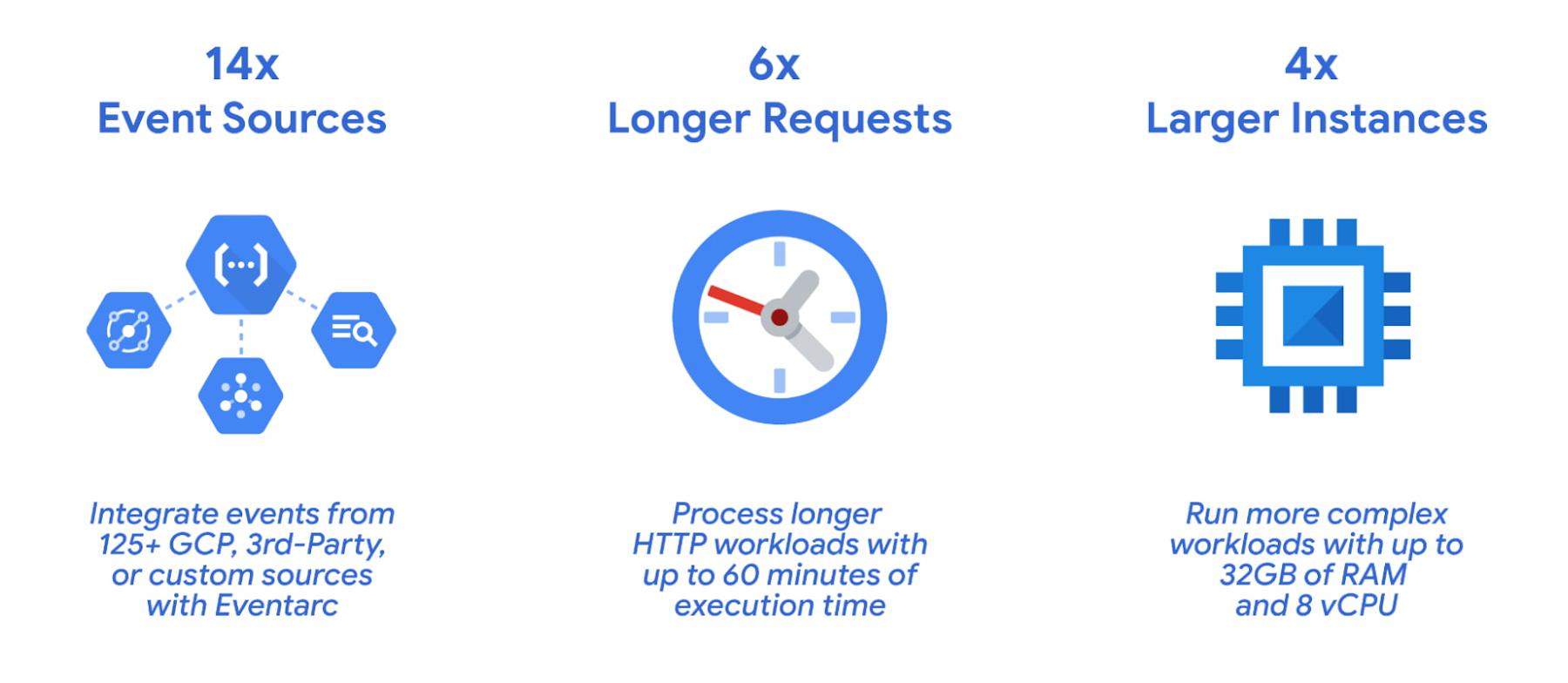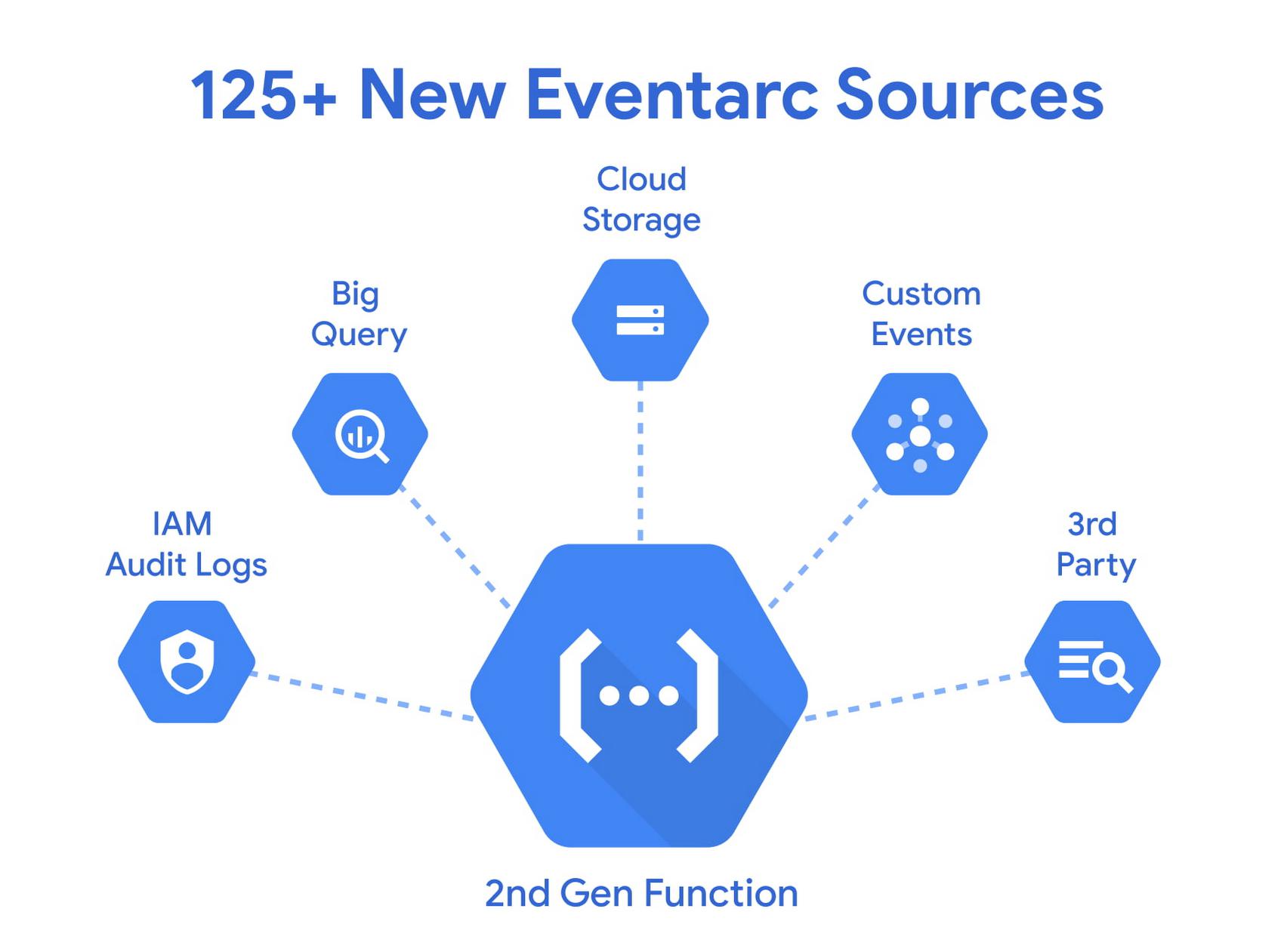For over seven years, Functions-as-a-Service has changed how developers create solutions and move toward a programmable cloud. Functions made it easy for developers to build highly scalable, easy-to-understand, loosely-coupled services. But as these services evolved, developers faced challenges such as cold starts, latency, connecting disparate sources, and managing costs. In response, we are evolving Cloud Functions to meet these demands, with a new generation of the service that offers increased compute power, granular controls, more event sources, and an improved developer experience.
Today, we are announcing the general availability of the 2nd generation of Cloud Functions, enabling a greater variety of workloads with more control than ever before. Since the initial public preview, we’ve equipped Cloud Functions 2nd gen with more powerful and efficient compute options, granular controls for faster rollbacks and new triggers from over 125 Google and third-party SaaS event sources using Eventarc. Best of all, you can start to use 2nd gen Cloud Functions for new workloads, while continuing to use your 1st gen Cloud Functions.
From our partners:
Let’s take a closer look at what you’ll find in Cloud Functions 2nd gen.
Increased compute with granular controls
Organizations are choosing Cloud Functions for increasingly demanding and sophisticated workloads that require increased compute power and more granular controls. Functions built on Cloud Functions 2nd gen have the following features and characteristics:
- Instance concurrency – Process up to 1000 concurrent requests with a single instance. Concurrency can drastically reduce cold starts, improve latency and lower cost.
- Fast rollbacks, gradual rollouts – Quickly and safely roll back your function to any prior deployment or configure how traffic is routed across revisions. A new revision is created every time you deploy your function.
- 6x longer request processing – Run your 2nd gen HTTP-triggered Cloud Functions for up to one hour. This makes it easier to run longer request workloads such as processing large streams of data from Cloud Storage or BigQuery.
- 4x larger instances – Leverage up to 16GB of RAM and 4 vCPUs on 2nd gen Cloud Functions, allowing larger in-memory, compute-intensive and more parallel workloads. 32GB / 8 vCPU instances are in preview.
- Pre-warmed instances – Configure a minimum number of instances that will always be ready to go to cut your cold starts and make sure the your application’s bootstrap time doesn’t impact its performance.
- More regions – 2nd gen Cloud Functions will be available in all 1st gen regions plus new regions including Finland (europe-north1) and Netherlands (europe-west4).
- Extensibility and portability – By harnessing the power of Cloud Run’s scalable container platform, 2nd gen Cloud Functions let you move your function to Cloud Run or even to Kubernetes if your needs change.
Lots more event sources
As more workloads move to the cloud, you need to connect more event sources together. Using Eventarc, 2nd gen Cloud Functions supports 14x more event sources than 1st gen, supporting business-critical event-driven workloads.
Here are some highlights of events in 2nd gen Cloud Functions:
- 125+ Event sources: 2nd gen Cloud Functions can be triggered from a growing set of Google and third-party SaaS event sources (through Eventarc) and events from custom sources (by publishing to Pub/Sub directly).
- Standards-based Event schema for consistent developer experience: These event-driven functions are able to make use of the industry-standard CloudEvents format. Having a common standards-based event schema for publishing and consuming events can dramatically simplify your event-handling code.
- CMEK support: Eventarc supports customer-managed encryption keys, allowing you to encrypt your events using your own managed encryption keys that only you can access.
As Eventarc adds new event providers, they become available in 2nd gen Cloud Functions as well. Recently, Eventarc added Firebase Realtime Database, DataDog, Check Point CloudGuard, LaceWork and ForgeRock, as well as the Firebase Stripe / Revenuecat extensions as event sources.
Improved developer experience
You can use the same UI and gcloud commands as for your 2nd gen functions as for 1st gen, help you get started quickly from one place. That’s not to say we didn’t make some big improvements to the UI:
- Eventarc subtask – Allows you to easily discover and configure how your function is triggered during creation.
- Deployment tracker – Enables you to view the status of your deployment and spot any errors quickly if they occur during deployment.
- Improved testing tab – Simplifies calling your function with sample payloads.
- Customizable dashboard – Gives you important metrics at a glance and the accessibility updates improve the experience for screen readers.
As with 1st gen, you can drastically speed up development time by using our open source Functions Framework to develop your functions locally.
Tying it together
2nd gen Cloud Functions allows developers to connect anything from anywhere to get important work done. This example shows an end-to-end architecture for an event-driven solution that uses new features in 2nd gen Cloud Functions and Eventarc.
It starts with identifying the data sources to which you want to programmatically respond. These can be any of the 125+ Google Cloud or third-party sources supported by Eventarc. Then you’re able to configure the trigger and code the function while specifying instance size, concurrency and processing time based on your workload. Your function can process and store the data using Google Cloud’s AI and data platforms to transform data into actionable insights.
Get started with the new Cloud Functions
We built Cloud Functions to be the future of how organizations build enterprise applications. Our 2nd generation incorporates feedback we’ve received from customers to meet their needs for more compute, control and event sources with an improved developer experience. We’re excited to see what you build with 2nd gen functions. You can learn more about Cloud Functions in the documentation and get started using Quickstarts: Cloud Functions.
By: Vidya Nagarajan Raman (Head of Product Management, Google Cloud) and Jaisen Mathai (Group Product Manager, Google Cloud)
Source: Google Cloud Blog
For enquiries, product placements, sponsorships, and collaborations, connect with us at [email protected]. We'd love to hear from you!
Our humans need coffee too! Your support is highly appreciated, thank you!












